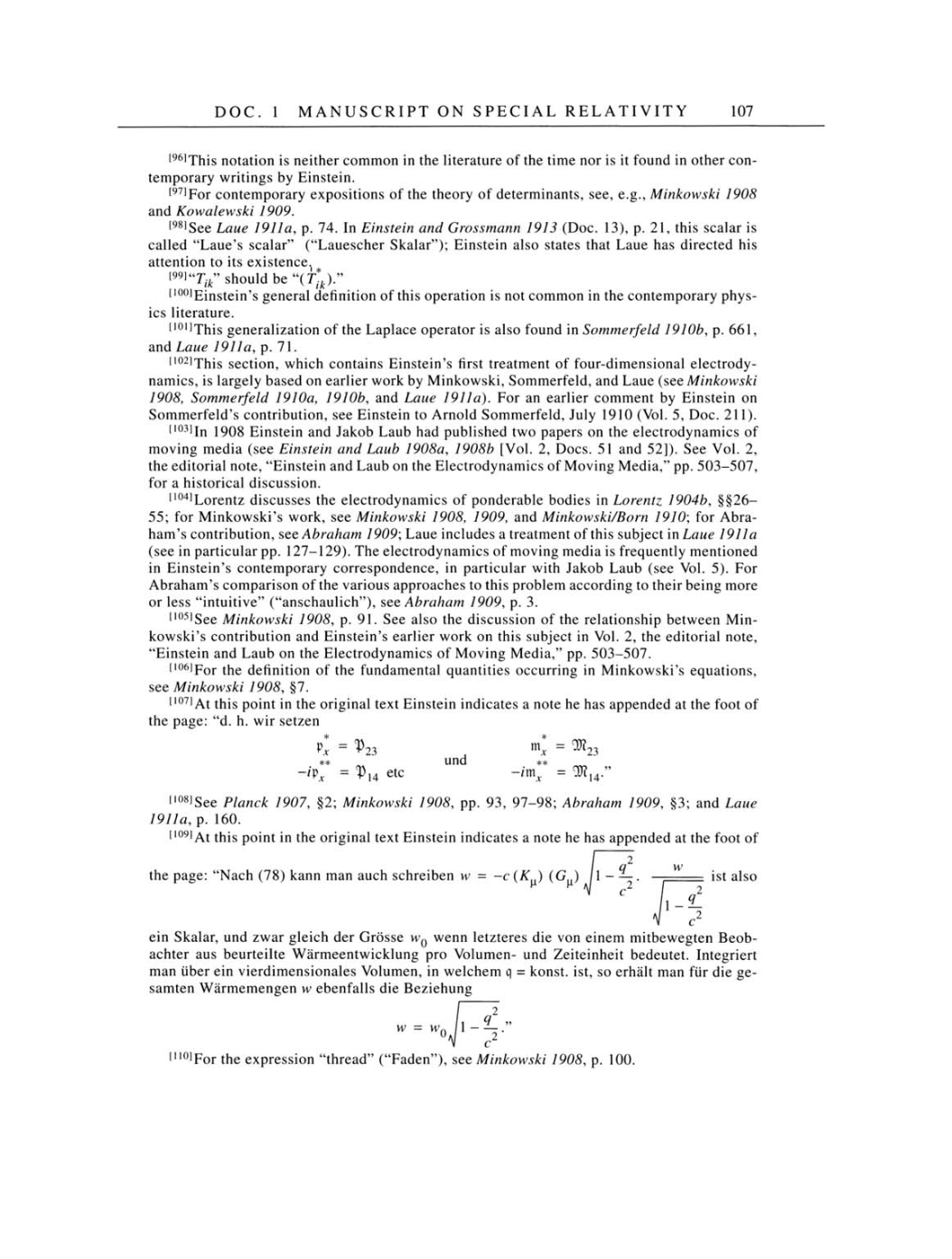DOC.
1
MANUSCRIPT
ON
SPECIAL
RELATIVITY
107
[96]This
notation
is
neither
common
in
the
literature of
the time
nor
is
it
found
in
other
con-
temporary writings
by
Einstein.
[97]For contemporary expositions
of
the
theory
of
determinants,
see, e.g.,
Minkowski 1908
and
Kowalewski
1909.
[98]See Laue
1911a,
p.
74. In
Einstein and Grossmann
1913
(Doc. 13),
p.
21,
this scalar
is
called "Laue's scalar"
("Lauescher Skalar");
Einstein also
states
that Laue
has
directed
his
attention to its existence.
[99]"Tik"
should
be
"(T*ik)."
[100]Einstein's
general
definition of
this
operation is not
common
in the
contemporary phys-
ics
literature.
[101]This generalization
of
the
Laplace operator
is
also found
in Sommerfeld 1910b,
p.
661,
and
Laue
1911a,
p.
71.
[102]This
section, which
contains Einstein's
first
treatment
of four-dimensional
electrody-
namics, is
largely
based
on
earlier
work
by
Minkowski, Sommerfeld, and Laue (see Minkowski
1908, Sommerfeld
1910a, 1910b,
and
Laue
1911a).
For
an
earlier
comment
by
Einstein
on
Sommerfeld's
contribution,
see
Einstein
to
Arnold
Sommerfeld, July 1910
(Vol. 5,
Doc.
211).
[103]In
1908
Einstein
and
Jakob
Laub had published
two papers
on
the
electrodynamics
of
moving
media
(see
Einstein and Laub
1908a, 1908b
[Vol. 2,
Docs.
51
and
52]).
See Vol.
2,
the
editorial
note,
"Einstein
and
Laub
on
the
Electrodynamics
of
Moving
Media,"
pp.
503-507,
for
a
historical discussion.
[104]Lorentz
discusses
the
electrodynamics
of
ponderable
bodies
in Lorentz
1904b,
§§26-
55;
for Minkowski's
work,
see
Minkowski
1908, 1909,
and
Minkowski/Born
1910;
for
Abra-
ham's
contribution,
see
Abraham
1909;
Laue includes
a
treatment
of
this subject
in
Laue
1911a
(see
in particular
pp.
127-129).
The
electrodynamics
of
moving
media
is frequently
mentioned
in
Einstein's
contemporary correspondence,
in
particular
with Jakob Laub
(see
Vol.
5).
For
Abraham's
comparison
of
the
various
approaches to
this
problem according
to
their
being
more
or
less "intuitive"
("anschaulich"),
see
Abraham
1909,
p.
3.
[105]See
Minkowski
1908,
p.
91. See
also
the
discussion of
the
relationship
between
Min-
kowski's contribution
and
Einstein's earlier work
on
this
subject in
Vol.
2,
the
editorial
note,
"Einstein
and
Laub
on
the
Electrodynamics
of
Moving
Media,"
pp.
503-507.
[106]For
the
definition of
the
fundamental
quantities occurring in
Minkowski's
equations,
see
Minkowski
1908, §7.
[107]At this
point
in the
original text
Einstein indicates
a
note
he has
appended at
the
foot of
the
page:
"d.
h.
wir
setzen
\x
= V23 mx =
^23
**
und
**
-P, =
Vu
etc
-imx
=
[108]See
Planck
1907, §2;
Minkowski
1908,
pp.
93,
97-98;
Abraham
1909, §3;
and Laue
1911a,
p.
160.
[109]At this
point
in the
original text
Einstein indicates
a
note
he has
appended at
the
foot of
the
page:
"Nach
(78)
kann
man
auch schreiben
w
=
-c
(Ku) (Gu)
ll
-
-
.
H
ist
also
C
/2
ein
Skalar, und
zwar
gleich
der Grösse
w0
wenn
letzteres
die
von
einem
mitbewegten
Beob-
achter
aus
beurteilte
Wärmeentwicklung
pro
Volumen- und
Zeiteinheit bedeutet.
Integriert
man
über ein vierdimensionales
Volumen, in
welchem
q =
konst.
ist,
so
erhält
man
für
die
ge-
samten Wärmemengen
w
ebenfalls
die Beziehung
2
C
=wo
1-
[110]For
the
expression
"thread"
("Faden"),
see
Minkowski
1908,
p.
100.
